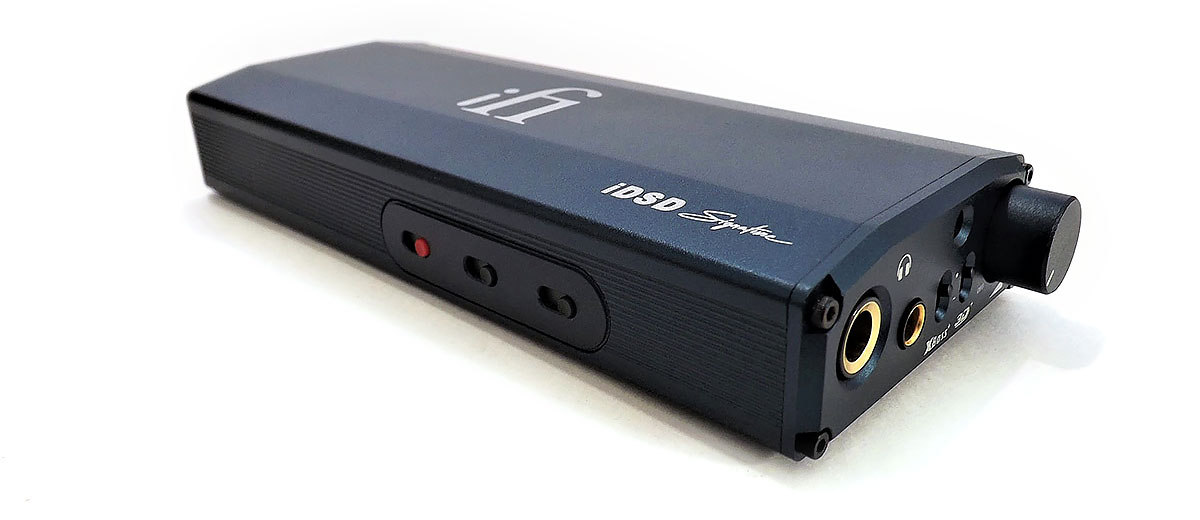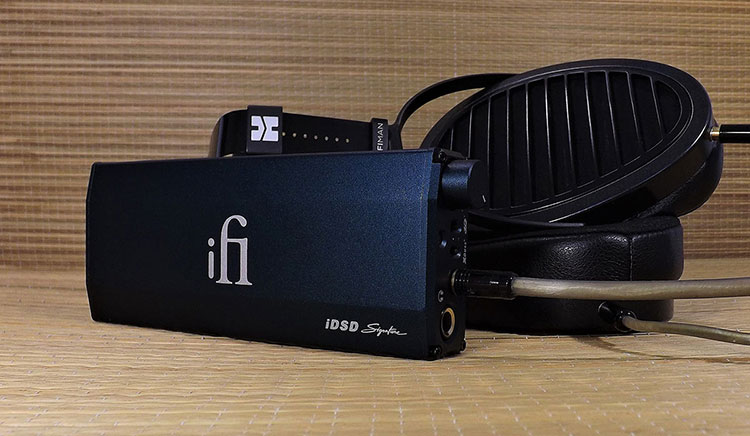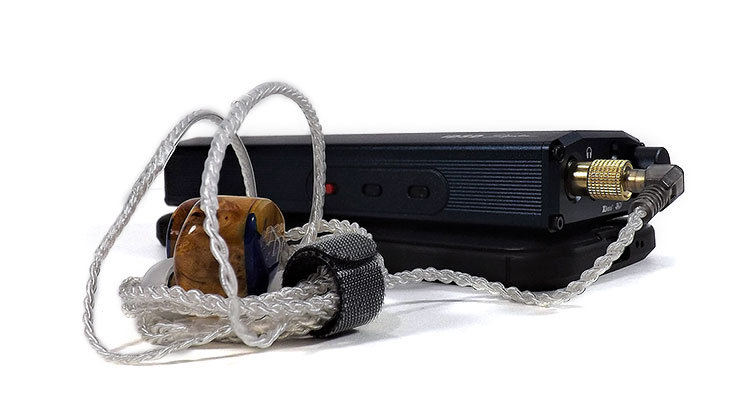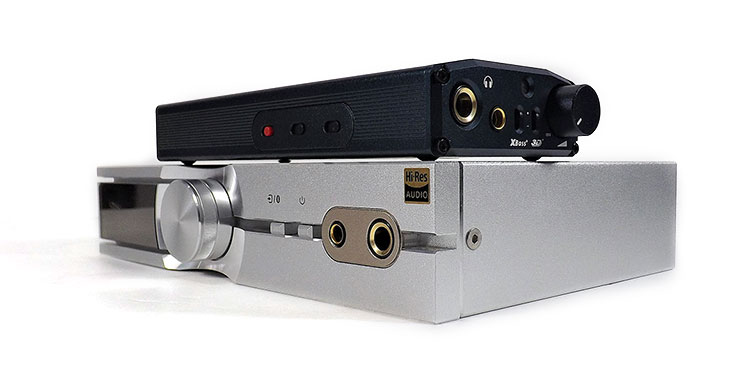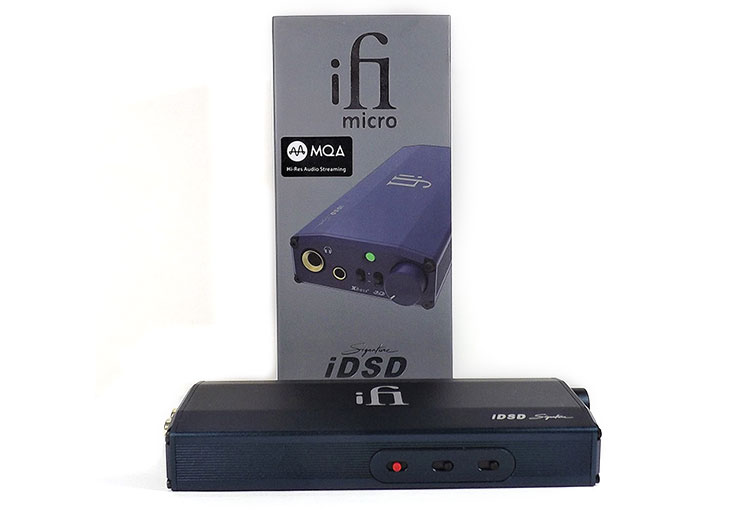Sound Impressions
The familiar iFi amplifier warmth is present, and it should not be a surprise since they all use Burr brown DACs and iFi custom OPamps. Good dynamics with lots of micro details are heard especially when you feed the Micro iDSD Signature through the USB input.
I would describe the general sound signature of the iFi Micro iDSD Signature DAC amplifier to be not only warm but punchy, dynamic, and powerful with a very good transient response. It might not be the cleanest power amplifier out there or the flattest sounding but indeed deserves the Hi-Res sticker for its excellent sound quality with low distortion.
One of the best aspects of the iFi Micro iDSD Signature DAC amp is that it can make some headphones sound better. For instance, if you have a bass deficient headphone, then turn on the XBass. What about a narrow soundstage? Then use the 3d which makes the sound more expansive and makes everything within a recording sound as if they had extra width.
It does not stop there. The DAC section can also change its sound signature as well especially when it comes to the soundstage. Listening to Classical music? I would definitely leave it on bit-perfect mode but what if you want a smaller space for a small Jazz club concert feel? Then use the DAC in the standard or minimum phase mode for a more up close and personal experience.
Synergy
The beauty of the iFi Micro iDSD Signature DAC amplifier is in its versatility to be many amps in one with a wide variety of sound signature sculpturing features. Versatility is what improves synergy and the iFi Micro iDSD Signature scores high in this department for sure as in other areas.
The combination of iEMatch, Power modes, DAC settings, XBass and 3d and all the variations possible in the sound signature plus portability is the reason why this unit is one of the most versatile I have used. This unit and all its features made it possible to use any IEM or headphone I own with great results.
Comparing it to other amplifiers, the Micro iDSD signature seems more powerful than specified as well. It could comfortably dish out a surprisingly high amount of power for its size while remaining cool to the touch and rarely getting warm to the touch.
Filtering
The iFi Micro iDSD Signature has a DAC section with 3 selectable filters or DAC modes. One of the switches on the side of the unit can be used to change the way the internal DAC works. There is the standard mode, but there is also a minimum phase mode along with a bit-perfect mode.
What changes did I perceive using this switch and feature set? The standard setting is just that, it sounds pretty good but up close and personal compared to the other two. When you switch over to the minimum phase, the soundstage seems to slightly widen and with the bit-perfect mode, the stage seems to widen even more plus additional depth and height were obtained.
Personally, I left the Micro iDSD signature on bit perfect all the time because from the 3 DAC settings, it was my favorite overall and to my ears had better dynamics with the widest soundstage which also seemed to gain some height over the other two and it gave a more realistic multidimensional soundstage on top of some other tonal quality improvements.
Selective Comparisons
Schiit Asgard 3 AK4490
Technical
The Asgard 3 is a very popular desktop headphone amplifier, and my particular unit has the AK4490 Delta Sigma DAC module which is a tried and true but somewhat dated warm-sounding DAC chip with a bloomy presentation and a decent soundstage.
Construction-wise, the Asgard is robust and the case is made of thick metal. It feels heavy in the hands and well constructed in the USA mostly from local sources. The current pricing of Schiit is quite reasonable for the quality you get and to me and one of the best bargains out there and Schiit is one of the companies that have more than one best bang for the buck items.
The Asgard 3 is a hybrid design with a line-in, one headphone 6.35mm single-ended output, a front-mounted volume control, and is rated at 5 watts per side at 16 ohms. Feature-wise, the unit seems puritan in design. In the case of this unit, there is an additional USB input.
Sound
One aspect which I find rather peculiar about the Schiit Asgard 3 is the amount of volume one has to apply regardless of source to obtain some decent volume levels. The Asgard with most of my headphones starts reaching a somewhat loud enough level past the halfway mark and some have to be turned up even higher.
This is a typical characteristic of the hybrid design amplifier which operates in class A up to the point where the amp reaches an 80% power output requirement, then it quietly switches over to a more efficient and more powerful class A/B to reach its full power output capability.
The iFi Micro iDSD Signature does not need to go much past the halfway mark to sound loud enough. Of course, the Micro iDSD Signature is the more versatile of the two but at double the cost. Another winning factoid about the Micro iDSD Signature is that although it’s only one-third of the size of the Asgard it seems to have just about the same amount of raw power.
Sound-wise, the Schiit Asgard 3 has a soft and warm character with good imaging, soft transients, a soft-sounding top end, a relaxed midrange response, and a somewhat bloomy bass response. I would say it assimilate the character of a hybrid tube amplifier.
The iFi Micro iDSD Signature is more dynamic in volume and transient response. The midrange is more forwardly presented and the bass response is tight and faster responding while the highs remain present and sharp but not overly hot or piercing.
iFi iDSD NEO
Technical
If you are looking for cleanliness, purity, and a desktop DAC amplifier combo that operates completely silent with the absence of noise, clicks, and pops, turn on or turn off thumps then the NEO fits that bill in spades.
The all-aluminum chassis has a variable textured finish but is absent of paint which in turn makes the finish more durable and more resistant to marring or scratches. The only area susceptible to scratches would be the digital display.
The unit, although absent of features manages to have some indispensable features like the XLR inputs along with a coaxial SP/DIF, an optical input plus a USB input. Connectivity is very good in my opinion. It also can output from any of those sources to either the RCA line outputs or over dual 3 pin XLR.
The iFi iDSD NEO also has Bluetooth but it can only receive an input source signal. I wished it could also output so I could use BT wireless headphones with the NEO however the inclusion of a remote control is a bonus and scores some points.
Sound
Some will immediately say the more obvious comparison should be with the Micro iDSD Signature against the iDSD Black Label however I do not have one to compare.
I have heard it and if I can recollect my memories well it sounded almost identical except for the Signature having an edge in midrange smoothness with a better bass response and the Signature to me also has an improved soundstage.
Other than that if you compare the NEO to the Signature they are highly contrasting to each other. One aims for audio purity and the other for musicality, versatility, and fun. The NEO headphone output and features lack power but are very clean sounding, more so than on the Micro Signature.
The NEO lacks the power to move power-hungry headphones like my Hifiman Aryas even through the balanced 4.4mm connector. The Micro iDSD Signature has four times the power at 4.1 watts compared to the 1 watt of the NEO and it shows. The Aryas are adequately powered by the Signature DAC amp even at half volume.
One thing that has to come to light is that the iDSD NEO DAC section is far superior to the DAC inside the Signature. The DAC portion of the NEO is super clean with no noise whatsoever and I have obtained some very good results using the NEO as a preamp using the XLR output ports and as an audio control center.
My current desktop setup consists of the NEO connected optically to my Soundblaster Z, outputting through the XLR to the Topping A90 which is rated at 7.6 watts and it’s a killer combo and a very trustworthy test bench with all the connectivity and power I need with fantastic fidelity.
Our Verdict
The size per performance of the iFi Audio Micro iDSD Signature DAC amplifier is unbeatable plus all the features are a bonus.
That said, the Signature is a fun machine capable of driving practically every headphone out there while at the same time remaining highly musical and hiss free and taking up a minimum amount of space on a desktop doing so.
Here we have a desktop or portable DAC amplifier combo with a high amount of power and low distortion, 3d and XBass, iEMatch, a 3-bit rate DAC setting, 6.35mm plus Pentaconn connectivity. Digital inputs plus the ability to amplify an analog signal with the ability to play any digital format all in a unit very small in size, I ask, what is there not to like her.
There is nothing to dislike about this model and, if I was told I could only have one desktop DAC amp combo and nothing else, the iFi Micro iDSD would probably be it for being so versatile and sounding so good and I highly recommend it without hesitation.
iFi Audio Micro iDSD Signature Specifications
IN/OUT
- Digital Inputs: USB 3.0 type A “OTG” Socket (USB2.0 compatible/with iPurifier® technology built-in), S/PDIF (3.5m coaxial/optical)
- Output Balanced: 4.4mm, SE: 6.3mm/RCA
DAC
- DAC Bit-Perfect DSD & DXD, PCM DAC by Dual-core Burr-Brown
- Clock Ultra low jitter GMT Femtosecond Clock
- Formats DSD512 / 256 / 128 / 64,
- Octa / Quad / Double / Single-Speed DSD,
- DXD (768 / 705.6 / 384 / 352.8kHz),
- Double / Single-Speed DXD
- PCM (768 / 705.6 / 384 / 352.8 / 192 / 176.4 / 96 / 88.2 / 48 / 44.1kHz)
- MQA
Filters
- DSD Extreme/Extended/Standard Bandwidth
- PCM Bit-Perfect/Minimum-Phase/Standard
- DXD Bit-Perfect Processing
Line Output
- Dynamic Range (Line) >117db(A)
- THD & N (0dBFS Line) <0.003%
- Output Voltage (Line) >2V
- Output Impedance <240Ω
- Jitter (correlated) Below AP2 test set limit
Headphone Power Output
- Turbo Mode Power (max) 10.0V/4,100 mW
- Power (continuous) >1,560 mW @ 64 Ohm >166 mW @ 600 Ohm
- Normal mode Power (max) 5.5V/1,900 mW
- Power (continuous) >100 mW @ 300 Ohm >950 mW @ 32 Ohm
- Eco mode Power (max) 2.0V/500 mW @ 8 Ohm
- Power (continuous) >250 mW @ 16 Ohm
- Dynamic Range (HP) >115dB(A) (Eco Mode, 2V Out)
- THD &N (HP 500mW/16R) < 0.008%
- Output Voltage (HP) >10V (Turbo Mode)
- Output Impedance <1Ω (iEMatch not engaged)
- Maximum Output Power 4,100 mW @ 16 Ohm Load
- Continuous Output Power 1,000 mW @ 64 Ohm Load
General Specifications
- Battery Lithium-polymer 4800mAh
- Power System Charging via USB-C, BC V1.2 compliant up to1500mA charging current
- Dimensions 172 x 67 x 27 mm
- 6.8″ x 2.6″ x 1.1″
- Weight 295 g (0.65 Ibs)

